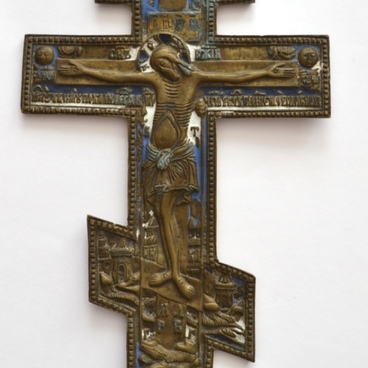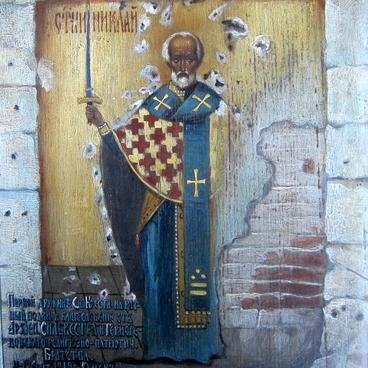The icon The Holy Head of John the Baptist dates from the turn of the 20th century. Its subject is based on the texts of the Holy Scripture. In Orthodoxy, John is called the Prophet, the Forerunner, and the Baptist. According to his hagiographies, he received these names for two important missions: he announced the coming of the Lord to the chosen people and baptized Christ in the Jordan River. After the Virgin Mary, he is the most revered saint among the believers.
The Holy Head of John the Baptist
Creation period
Late 19th – 20th century
Dimensions
355x29 cm
35.5х29х2.5 cm
35.5х29х2.5 cm
Technique
Oil on wood; painting
Collection
Exhibition
1
Open in app#1
Unknown Author
The Holy Head of John the Baptist
#4
#2
Only the Apostle Luke wrote about the Forerunner’s childhood. His parents were the priest Zechariah and Elizabeth, an elderly barren couple. The apostle describes how one day the Archangel Gabriel announced to the priest that he would have a son: “Many shall rejoice at his birth, for he shall be great in the sight of the Lord”. According to the Gospel, St. John was born six months before Jesus Christ and is His distant relative.
John the Baptist managed to avoid death during the massacre of the innocents in Bethlehem. Together with his mother, he settled in the desert, and when he grew up, he began to prepare himself for the service of Christ, reading prayers and observing fasting. John wore simple clothes, girdled with a leather belt, fed on honey of wild bees and locusts. The saint had stayed in the desert until the age of thirty, when Jesus told him to deliver the main sermon to the people.
#6
Thus, John became a prophet: on the banks of the Jordan he had to fulfill his first mission – to prepare the people for the appearance of Christ and the study of the Gospel. The people gathered by the river for ablutions, before entering the water, listened to the sermon and were morally purified. There John baptized Jesus himself. After the baptism of the Saviour, St. John solidified his prophetic ministry and became an accuser of vices among the poor and the noble.
#3
John openly condemned the king Herod for living with Herodias – his brother’s wife. For this, the ruler of Galilee became angry and locked the Baptist in prison. During a feast in honour of the ruler’s birthday, the daughter of Herodias, Salome, enchanted Herod and his guests with a dance. For this, the king promised to give her everything she wanted. By arrangement with Herodias, Salome demanded St. John’s head on a platter. Herod treated the prophet with respect and was distressed by the daughter’s desire. But he kept his oath: a guard cut John’s head off. The queen left the saint’s desecrated head in the street.
St. John’s disciples buried his body in the city of Sebastia. According to life testimonies, afterwards his truncated head was wonderfully found three times: for the first time on the Mount of Olives, then in Jerusalem, and for the third time – on the territory of the Roman Empire. The parables about this led to the appearance of a separate type of icons – the Honourable Head of St. John the Forerunner.
In the folk tradition, the Nativity of John merged with the pagan rituals for the feast of Ivan Kupala. The popular name came from an association with ‘bathing’ and the baptism of Jesus Christ in the Jordan.
In the folk tradition, the Nativity of John merged with the pagan rituals for the feast of Ivan Kupala. The popular name came from an association with ‘bathing’ and the baptism of Jesus Christ in the Jordan.
#8
An unknown author painted the icon with oil on wood. The head of the prophet lies on a platter and is surrounded by a halo. Details are large and distinct, because they are considered essential for the icons depicting the saint after the execution.
#9
Iskitim Municipal Museum of Arts and History
read morehide
00:00
00:00
1x
The Holy Head of John the Baptist
Creation period
Late 19th – 20th century
Dimensions
355x29 cm
35.5х29х2.5 cm
35.5х29х2.5 cm
Technique
Oil on wood; painting
Collection
Exhibition
1
Open in app
Share

